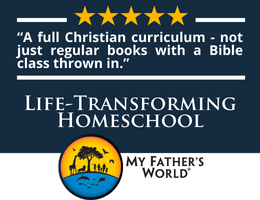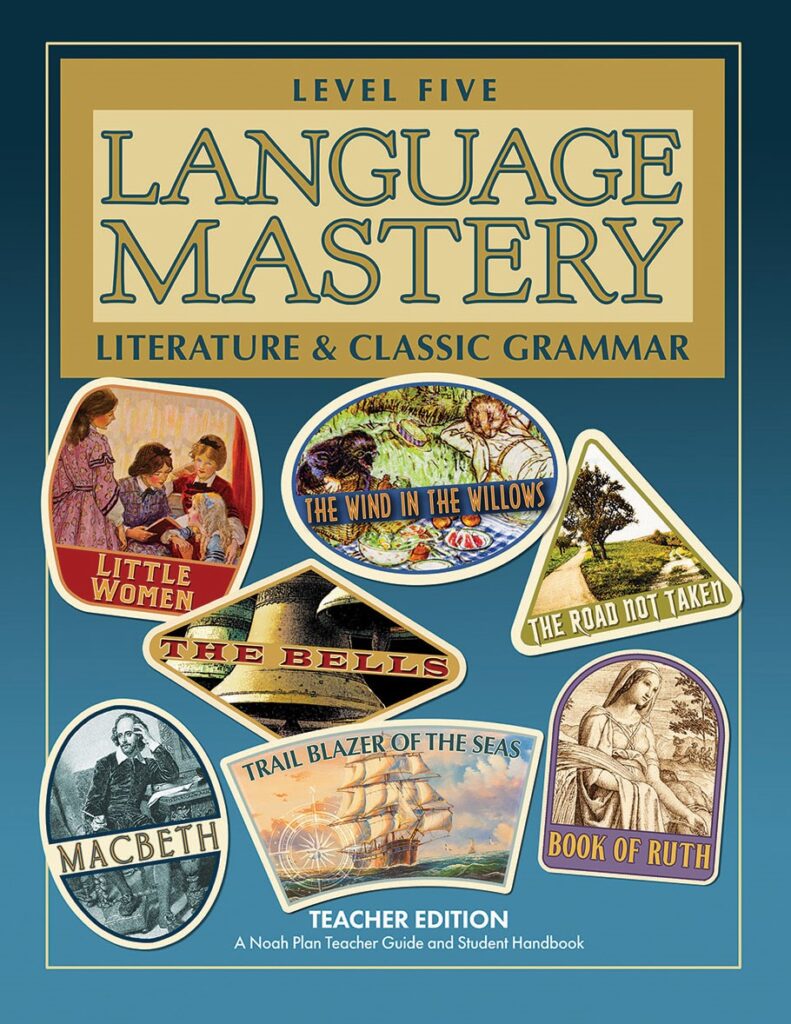The Foundation for American Christian Education (F.A.C.E.) created curriculum guides with detailed instructions for teaching history and geography, English, literature, reading, mathematics, art, and science. The methodology can be challenging for teachers to implement, so F.A.C.E. is creating grade-level courses that make it easier to teach. They have begun publishing their Language Mastery program that combines English language arts lessons and literature, beginning with courses for Level Four and Level Five for grades four and five.
Each course has two full-color books: a teacher edition and a student handbook. The last two-thirds of each teacher edition consists of the student pages, which explains why teacher editions are about 350 pages long.
In addition to one of the grade-level courses, classroom teachers and homeschooling parents need three F.A.C.E. publications: the Noah Plan English Language Curriculum Guide (NPEG); the Noah Plan Literature Curriculum Guide (NPLG); and the American Dictionary of the English Language, Noah Webster 1828 Facsimile Edition. Also required are a Bible (King James Version), How to Teach Spelling (Educators Publishing), and the literary works to be studied that year.
The goals of these courses are both broader and more ambitious than those for most language arts programs for comparable grade levels. Students use classic literature, poetry, and the Bible to learn literary appreciation, literary analysis, vocabulary, spelling, grammar, and the expressive arts of penmanship, composition, and public speaking. These skills are combined with deep analysis of biblical principles and philosophical/historical concepts about God’s work through both individuals and nations to help students develop a biblical worldview and Christian character traits.
In addition to the Bible, the literary works studied in Level Four are:
- Carry On, Mr. Bowditch, by Jean Lee Latham
- Treasure Island, by Robert Louis Stevenson
- Stories from Shakespeare, by Marchette Chute
- The Secret Garden, by Frances Hodgson Burnett
Those for Level Five are:
- Trail Blazer of the Seas, by Jean Lee Latham
- Little Women, by Louisa May Alcott
- Stories from Shakespeare, by Marchette Chute (Note that this book is used for both Levels Four and Five.)
- Wind in the Willows, by Kenneth Graham
Poems and scripture passages are also included within the course books. The literary works are to be read aloud, and students use passages from them for both literary and grammatical analysis as well as for developing an understanding of scriptural principles and key ideas taught in the courses.
Notebooks
Students need a three-ring notebook that will contain the large amount of written work they will do. The notebook is set up during the first week, with tabbed dividers for Orthography, Etymology, Composition, Prosody, Syntax, and The Classics. Under The Classics, students create a section for each literary work they study.
Students also copy out a detailed list of “notebook standards” they commit to following, such as, “I use one color ink throughout my notebook, either blue or black ink,” and “I will correct errors by drawing one line through the error and writing the correct word above it neatly.” Some of the standards identify what is entered on pages under each of the six tabs.
The appendix of the teacher edition has several important resources that should be copied for students and put in their notebooks for easy accessibility. Among them are a chart of sentence patterns, a 10-page “Classic Grammar Parsing Reference,” a “Book Review Format” with instructions and a record-keeping chart, and a “Glossary of Literary Terms. There are also forms that students will fill in for sentence and word analysis.
Students learn how to make entries for weekly sentence and word analysis, a weekly composition, spelling, penmanship, grammar rules and examples, sentence analysis, sentence diagrams, compositions, and notes on the literary works.
Composition work consists of paragraphs, short essays, book reviews, poems, and other assignments. In addition to the written work, students practice public speaking every day. They memorize and recite poems and scripture verses, and they present oral book reviews. Spelling, phonics, penmanship, and elocution are linked together as students study phonograms and spelling rules, and as they listen and write words. (The approach for this is based on The Writing Road to Reading as explained on pages 89 to 91 of NPEG. This is only one of several instances where the courses are dependent upon the other required resources.)
Notebooks are graded quarterly according to the standards presented at the beginning of the course.
Student Handbooks
Student handbooks are much more comprehensive than their title sounds. The handbooks guide students through lessons, including elements such as background and analysis for literary works, vocabulary words with their definitions, sample characterization charts, discussion questions, instruction on how to write various types of compositions and poems, and assignments for notebook work on etymology, syntax, composition, and prosody.
A parent or teacher reads aloud and discusses the literary works using the questions supplied in the student handbook, guides discussions about scripture and key ideas, and listens to recitations, but otherwise, students should be able to complete much of their work independently once they understand how the courses work.
Teacher Editions
Lesson plans are arranged by quarters of the school year, and each quarter presents weekly lesson plans on one- or two-page charts that summarize tasks. Additional pages between the charts expand on themes, settings, literary aspects, etc., varying according to the goals of the lessons. Teachers need to refer to the student handbook pages in the last two-thirds of their books for complete lesson content.
Teachers are expected to spend significant time preparing for lessons. In addition to the F.A.C.E. resources listed near the beginning of this review, teachers are directed to use many others as aids for lesson preparation, even though they are not listed as required resources. For example, the F.A.C.E. book Teaching and Learning America’s Christian History fully explains some of the leading ideas taught within these courses, as in the following instructions before teaching Carry On, Mr. Bowditch in the fourth-grade course.
1. Read these passages from Teaching and Learning America’s Christian History, Rosalie Slater, FACE to understand the American Christian character:
a. “An American Education,” p. xiii
b. “America’s Heritage of Christian Character,” pp. 73-75
c. “America’s Heritage of Christian Character—Key to the Third Principle,” pp. 210-229
There are no answer keys. As teachers prepare the lessons, they are to complete the student pages in their book themselves, in effect, creating their own answer keys. Teachers are expected to be familiar with the analyses, the literature, sentence diagrams, etc., well enough to grade them. (Note that Chapter 5 of NPEG explains and demonstrates sentence diagramming, and several other learning methods used in the courses are also explained in NPEG.)
Realistically, I doubt most homeschooling parents have the time to complete all the lesson preparation recommended for these courses. Consequently, those already familiar with F.A.C.E. and its philosophy and teaching methods should find it much easier than those with no prior understanding.
Summary
Granted, these courses require significant preparation time, but homeschooling parents who want to implement F.A.C.E.’s methodology for teaching language arts are likely to find the Language Mastery courses a godsend that saves a tremendous amount of work.









